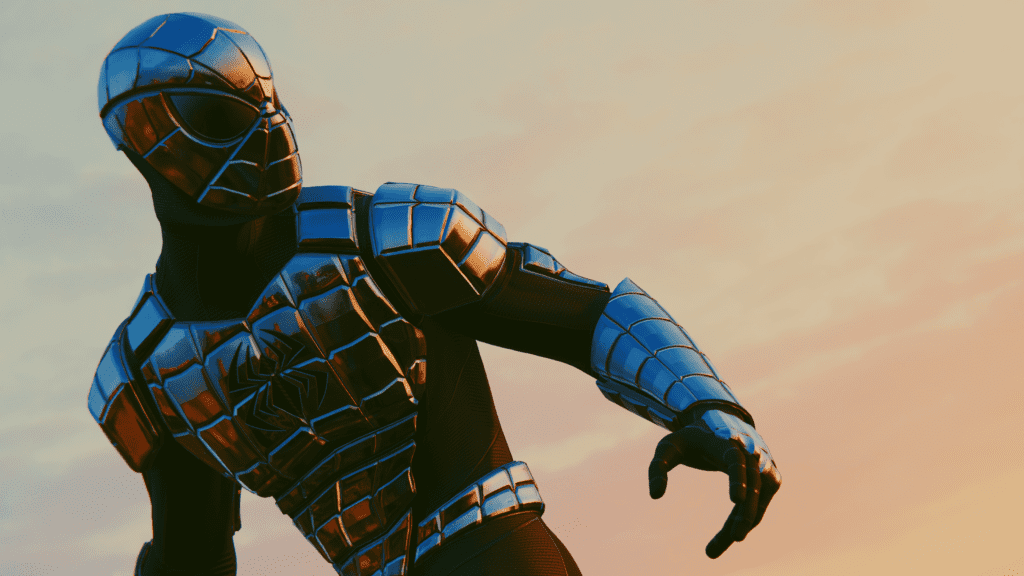The Spider-Man at the heart of Insomniac’s original story is one seasoned in the art of web-slinging. Out of his teens and embracing adulthood, Peter Parker’s balance between his academic career, charity work and social life seems stable enough to not completely consume him, but tenuous when leveraged against his life behind the mask. As many of his relationships become strained by the pressures of his competing responsibilities, it’s Parker’s exhaustive juggling act represents the biggest threat to his alter ego as the story commences. Though even as his greatest foes sit behind bars and his past relationships threaten to disappear, their paths remain intertwined. Comforting in its familiarity, Spider-Man’s pre-existing history is used as a foundation for its narrative, bedding the character into a world that has come to know the spider long before the arrival of the author. His future however is more of an open book, with Insomniac striving to recount a story as unique as it is memorable, all while steeped in copious amounts of renowned source material.
PlayStation’s Spider-Man opens with the red and blue crusader at the height of his popularity, and as much a staple of Manhattan as corner-side hot-dog vendors and traffic congestion. Meted out in dialogue fragments, environmental design and collectables is the story of the spider so far – an inextricable web weaved of battles fought against iconic villains and relationships forged with series stalwarts. Told across a twenty-hour narrative removed from all additional side activities, Spider-Man’s newest adventure is one that plays on the aforementioned desire for control over all aspects of his life, and the ensuing fear that stems from a self-imposed duty to protect. It’s a story that moves to a simple beat, and one that thankfully forgoes retelling Parker’s origins in favour of focusing on a more established hero. Impressively, it’s a story that’s also reserved where it needs to be. With a veritable glut of villains to place in opposition to the protagonist, Insomniac’s considered approach manages to keep the story focused and consistent, rather than lost amidst a scattershot roster of unconnected characters. The result is an engaging narrative that even manages to stifle a few surprises, but one weighted heavily in favour of its first and final chapters, leaving a middle act that unfolds at a noticeably slower pace.
The base structure of Spider-Man isn’t all too different from your typical open-world experience. Prying yourself away from the main narrative, Manhattan is unveiled before you as a haven of collectable trinkets, enemy encampments and side missions that offer the same blend of action, albeit with much lower stakes. Initially, the return of radio towers poses cause for concern, their inclusion an archaism adopted by many similarly sized game spaces. But very quickly, the few towers in need of activation become replaced by parcels of content that, while feeling familiar, seem altogether better suited to the game’s inherently quicker pace and fluid traversal. Collecting backpacks is as simple as locating and interacting with them in order to convert them into upgrade tokens, but freely swinging and gliding across block by city block in order to complete your collection feels anything but a chore. And it’s the same for the game’s side-missions, too. While such content isn’t particularly inventive or anywhere near as captivating as the core plot, it at least plays to the game’s strengths, rather than detaching itself like a few select missions that are utilised within the main narrative. Faced with successive fights against packs of snarling Rykers escapees or rogue mercenary cliques, an intuitive and multifaceted movement system allows players to add their own touch of flair to every engagement. And even as a quest for perfect completion denotes the ticking of check-boxes and clearing of map markers, Spider-Man’s cultured motion remains a wonderfully freeing detraction from the pitfall of repetition.
As Parker regularly points out, enemies of the Spider-Man are lurking around every corner, the ascension of New York’s brand of super-villains going a long way to ensuring that his services remain in demand. As the likes of Scorpion, Rhino and the Vulture become acquainted with the prison walls inside of the maximum security ‘Raft’, there are still plenty of others eager to leave their mark on Spider-Man, and plenty more ways for him to put them right back behind bars.
NEVER LOST WITHIN ITS OWN LORE, SPIDER-MAN’S STORY IS CONCISE & THOUGHTFUL
Combat in Spider-Man evokes a fluidity and elegance similar to that of its movement system, with an emphasis on responding to attacks with offensive flourishes rather than all-out aggression. The majority of fights outside of boss battles stack the odds in favour of the opposition – enemies attack in large numbers, often wielding weapons, and they aren’t afraid of a challenge. Managing every conflict comes down to delving deep into your repertoire of abilities and immobilising as many enemies as possible. Gadgets such as the Web-Bomb can ensnare several enemies at once, while the Concussive Shot is powerful enough to send surrounding foes hurtling into the distance. Build up enough of an uninterrupted combo and you generate ‘Focus’, which can be used to restore a portion of your health or execute a final blow on an enemy. Progressing through each skill tree and improving your suit abilities helps reflect a growing sense of personal experience, but in remaining consistent with how the story portrays Parker’s strength, levelling up is perhaps better viewed as an opportunity expand your arsenal of offence. As your skills improve, evolving into uniquely tailored methods of offence, avoiding every bullet and baton thrown at you becomes an exercise in maintaining your own high standards. And as your combos begin to tick over to increasingly greater heights, the state of zen that accompanies a flawless execution of enemy combatants eases into a gleeful addiction.
Like the heroism and self-sacrifice that the arachnid fastened to his chest represents, the vertical sprawl of Manhattan is integral when it comes to characterising the Spider-Man. By day and by night, New York hums with life, its lofty concrete spires and glimmering high-rises leaving the ambling populace below cast in shadow. You’ll likely not be spending too much time at street level, but the consistent level of detail from monument to marketplace sees that the intricacies of the city’s design aren’t washed away by its scale. The sidewalk and skyline represent two different worlds in Spider-Man, but even as taxi cabs become imperceptible yellow flecks sunken deep into the grey maze, the game’s verticality feels distinctly normal.
Sewn into the very fabric of the experience, the movement of Spider-Man is fantastically realised and remarkably accessible. Condensed into a simple two-button system, swinging, vaulting and gliding becomes second nature from the moment that you make your first leap towards the clouds. Much like in combat, chaining together various traversal techniques helps keep mobility unhindered, an emphasis on fluent motion denoting that every web fired will seek a surface and continue to propel you ever-forward. Whether it’s the glassy face of a towering office block or a rickety rooftop awning, anything that may be considered an obstacle to progress is instead a method of maintaining momentum. Spider-Man has been built upon the bedrock of its movement system, encompassing the character’s defining speed and agility into every perilous dive and fearless free-fall. And as Insomniac’s technical mastery allows all players to control Spider-Man with a similar sense of style, it’s this wordless expression that serves as the game’s greatest testament to the character.
Much like the hero at its heart, Insomniac’s Spider-Man is imperfect, though the ambition of the game is worth so much more. Long removed from the sea of colourless columns that comprised Spider-Man’s original PlayStation adventure, Insomniac’s interpretation of Peter Parker falters without falling, the game a wonderful realisation of the character that’s positively brimming with energy. And though the world around him may lack the same distinct spark of life, Spider-Man’s charm alone is enough to carry the game through to its conclusion, every quip and exasperated groan endearing him that little bit more.

